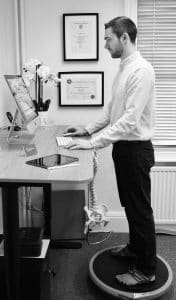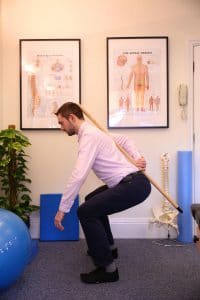Our Approach
Derby Chiropractor: Andrew Harlow’s thoughts on back pain
If you are from Derby or the surrounding areas and have back pain, then this page is designed to give you a bit more detail and background to aid you – whether it is helping your understanding of what your back pain is, how it happened, or your best treatment and self-care options – we will cover it all here.
What is back pain?

Pain is your body’s way of telling your brain that there is something wrong – it is a good thing as if there was no pain signals you could really cause some damage. For lower back pain, these signals tend to come from sensors in the joints, ligaments, muscles and nerves. Specific conditions that can cause pain are:
- sacro-iliac (pelvic) joint dysfunction
- local muscle spasms and tightness
- disc herniations or bulges into the spinal canal
- impingement of the nerve root at the intervertebral foramen
- nerve root inflammation from facet joint sprains or local muscle strains
- referred pain from local trigger points within muscles,
- and many more
As you can see there are actually many forms of back pain – and if the advice is simply to rest or take pain medications to mask the pain then to be honest it doesn’t matter as much which type you have, as the advice would be the same. But for the best answers it would of course be beneficial to know which version of the above you have.
Once you know a specific cause and the underlying reason then you can manage it much more effectively, especially if you can figure out why it happened to begin with and find the root cause.
Why does back pain happen in the first place?
Where your back pain is coming from, and why it happened are two different things. If we are going to know how best to treat your back pain, and the best advice we need to give you for self-managing and preventing it from coming back, then we need to know how and why it started in the first place. There is nothing worse than getting rid of the pain, only for it to repeat itself – that can be very frustrating for all involved!
It is quite common for patients to be in severe pain with their back and not know why it came about, so many times will patients say ‘it just came on’. And that is normal as 95% of problems we see in clinic have this same feature – the problem builds slowly going ‘under the radar’ until one more episode of tension or pressure tips it over the edge and it forms symptoms.
We have 4 in depth articles discussing the cause and effect relationship which can result in putting pressure on the discs and joints in the low back – which show how your whole body is connected. In our ‘causes of low back pain and sciatica’ series we explore some very common, yet largely ignored causes of low back pain and sciatica which are very intriguing and appear ‘unusual’ at first:
Part 1 discusses how neck issues can cause pressure in the low back
Part 2 gives an example of how ankle joint stiffness causes the issue
Part 3 highlights the importance of posture and rounding the shoulders
Part 4 discuss a specific foot problem called ‘over pronation’
How is low back pain diagnosed?
Firstly we would want to know if there are any medical reasons which could be underlying and causing the back pain which are not appropriate for manual treatment and need to be sent to the GP for medical attention. We call this ‘ruling out red flags’.
Chiropractors are registered with the GCC and have had a minimum of 4 years extensive training. Modules within the training course include pathology, medical history taking and examination, pathology, orthopaedic evaluation, and Chiropractic treatment techniques specifically for the spine and sciatica – as such Chiropractors are well placed to assess and treat patients with back pain safely.
You can find out exactly what to expect in an initial consultation here, however for a physical assessment for someone with sciatica we would include:
- Postural analysis
- Neurological examination – to see if any nerve root(s) are affected
- Orthopaedic testing – specific tests to identify mechanical conditions
- Joint and muscle assessment
- Functional testing – checking how your body is working for you
Chiropractors assess the whole body and truly understand the longer term changes and compensations which can result in dysfunction and injury. Or basically we understand cause and effect. Causes of back pain can be from poor bending technique or something as silly as sitting on your wallet in the back pocket! If we can treat a patient to resolve the symptoms of back pain, and also have figured out the exact cause in the first place, then it greatly minimises the risk of it coming back again and everyone is happy.
The best approach for treating back pain

Hopefully we have already set the scene for this with everything discussed above – for us at Chellaston Chiropractic Clinic we believe the most important thing is to find out the root cause of any injury causing someone’s pain. It allows targeted advice, which then allows us to be more effective in helping people with their back pain. Once we know this we can create the best plan for getting patients better quickly – and this will be different for everyone.
We have many different treatment tecniques that we can pick and choose from to help us do this.
4 tips on how to prevent back pain
You ideally need to know exactly where your back pain is coming from in the first place, however if you have had back pain in the past, or had treatment from us and now need to know how to prevent it, here are the best tips:
1. Stop bending for damaged discs
The main advice we emphasise to patients with back and disc problems is to minimise bending as much as possible. This doesn’t just mean bending to lift things which are heavy, this means not bending when you are getting out of bed, brushing your teeth, washing your face, putting on your shoes or socks, preparing food in the kitchen and so on. Every time you bend improperly you will put pressure on the discs and if they are bulging onto the sciatic nerve this will not help. Once you have had treatment it is easier to move your body and your Chiropractor will show you how to lean and reach correctly minimising the strain on the back. Until then just try your best not to bend over as often!
2. Pick the ‘go to posture’ for your work
So it makes sense that if you are at work for 8 hours a day, and you are in the same office chair, you want to make sure that it is set up correctly for you! I keep on saying ‘for you’ because everyone is different, and you will need to modify the sitting position so it suits you best. Ideally for working on a computer, you want the top of the screen at your eye height, your elbows at desk height, and your hips slightly above your knees to minimise the bending strain on your lower back (if the knees are above the hips then it creates pressure on the base of the spine).
So get this set up to ensure even if you do nothing else, your posture won’t be as bad through the day as it could be! This step is damage limitation and once set up you can forget about it and enjoy the passive benefits.
3. The best posture is a varied posture

OK so forget what I said above! Well, some of it. The true ‘best posture’ isn’t going to be staying in the same position all morning – even if you have set up your desk and chair perfectly. The best solution is actually to have your default ‘go to’ set up as above, but then change the position of the chair or yourself throughout the day.
For changing the chair this is basically dictated by how many levers there are on the side. Learn what each of them does and make the most of it – try and find at least 2 other positions in addition to the one above.
For changing yourself this might be the option if you have a basic office chair without all of the gadgets, or if you are working from home i.e. at the kitchen table etc. The key here is to get your body into a few different positions to spread the load. If you cross your legs over one way, later on cross them over the other way. Instead of always crossing the legs one over the other get both feet on the floor flat and sit bolt upright for a few minutes. Basically you need to fidget without drawing too much attention to yourself.
Change the position of either your chair or yourself every 20-30 minutes throughout the day.
4. Make use of those shoulder rolls to minimise upper back and neck postural strains
A nice and simple one here that doesn’t impact on your work schedule. Ideally you would be going for a walk frequently or doing some stretches, however that isn’t practical when on a phone consultation or when you have a deadline to meet. So a simple one here is to roll the shoulder blades in circles from front to back 10-15 times as required (frequently throughout the day).
This movement loosens up tension between tight muscles, stretches the chest muscles back which are pulling you forwards, and also wakes up those muscles in between the shoulder blades. All good things for your neck and back.
Summary
At Chellaston Chiropractic Clinic in Derby we believe prevention is better than cure, but appreciate by the time we realise that we might need to do some quick treatment to get you out of trouble, and then we can focus on making those preventative changes which will have a great impact over a longer period of time to prevent your back pain from coming back.
If you need help for your back pain please book in to see us or call reception and we will look forward to helping you.
Andrew Harlow – Derby Chiropractor

